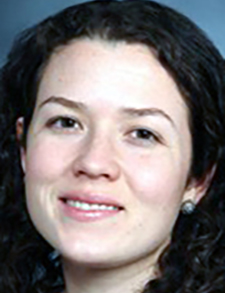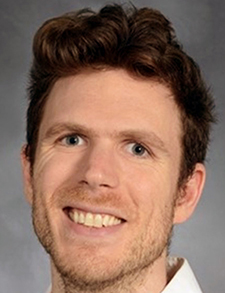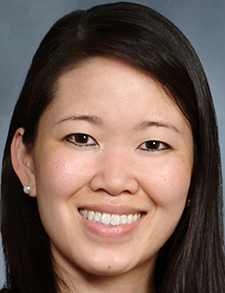
Diverse mid-adult nurses, mature adult hospital administrators, and senior adult doctors are standing around a table in a hospital board room. They are reviewing spreadsheets and charts containing financial information for a hospital during a board meeting. Staff is wearing professional clothing, scrubs, and lab coats.
As emergency rooms and hospitals are increasingly overwhelmed by pediatric patients with respiratory illnesses, concerns about how the current workforce will care for the influx of patients are increasing, and hospitals are beginning efforts to redeploy physicians.1
During the COVID-19 pandemic, the redeployment of clinicians was frequently used to care for the influx of patients. However, many physicians and trainees who were redeployed reported high levels of insomnia, anxiety, stress, depression, and low morale.2,3,4
In March 2020, as New York City became the COVID-19 epicenter in the U.S., our adult hospitalist group created a Redeployment Task Force to expand our capacity to care for hospitalized patients. We aimed to create a supportive onboarding process and team structure to foster high-quality patient care and clinician well-being.
Our group redeployed more than 125 attendings, advanced practice professionals (APPs), and trainees. In this perspective, we recommend a systematic framework for expanding and supporting the workforce using our lessons learned and the best evidence in the literature, which can be applied to the current surge in hospitalizations for pediatric respiratory viral infections.
Establishing a redeployment task force
Assembling a redeployment task force composed of clinicians and administrators with expertise in educational and organizational leadership is key. Members should have strong clinical and institutional knowledge, understand the complexities of delivering care, and be able to support redeployed clinicians.
The redeployment task force should be able to meet daily over virtual platforms and should have decreased clinical duties during the initial planning and implementation to allow for successful execution.
Administrators on the task force must have access to census numbers and projected staffing needs. Engaging key stakeholders across the institution, including deans, department chairs, division chiefs, and hospital leadership is critical to ensure priorities are aligned in developing and executing a redeployment program.
Recruiting and scheduling the workforce
Recruitment should be thoughtful and should prioritize skills and expertise which can translate to working on the inpatient pediatric service.5
We conceptualized recruitment for redeployment on the hospital medicine wards as filling two essential roles—the hospitalist role and the first call provider role, which is in line with what other programs found.
It was more important to recruit based on skill rather than by specialty.5 Individuals who can take on the traditional pediatric hospitalist role in assessing patients, developing plans of care, and managing medical comorbidities are clinicians with prior hospital medicine experience, outpatient general pediatrics attendings, family medicine attendings, or pediatric subspecialty fellows or attendings.
First-call providers should be well-versed in the electronic medical record and hospital system. They enter orders, collaborate with the interdisciplinary team, and ensure plans are appropriately executed.
Non-pediatric residents and APPs with inpatient experience may fill this role. Ideally, clinicians should be given agency to determine their assignment and the redeployment task force should allow for flexibility in clinical assignments.
Redeployed clinicians with the most experience in pediatric hospital medicine should be scheduled in clinical positions with the highest needs and least supervision (i.e., nights, or less-resourced sites). Faculty with less inpatient experience should be assigned to more resourced teams (i.e., house staff teams). Some faculty may require a training period. Staffing plans should anticipate members of the workforce who are unable to work due to illness or medical conditions.
Preparing for redeployment
Successful redeployment onboarding includes educating and preparing clinicians for clinical service and fostering a supportive atmosphere.3,5,6
A multifaceted approach, which includes compiling key resources onto an online platform and orienting clinicians through video conferencing, is recommended.
Key resources should include clinical best practices, roles, and responsibilities of team members, workplace logistics, electronic medical record training, well-being support resources, and contact information. An online platform with materials encourages self-directed learning which is compatible with adult learning principles.6
The redeployment task force can orient clinicians using an interactive video-conferencing platform.
Orientation should relay information about the team structure, logistics, and expectations, and should provide an opportunity for the redeployment task force to connect with anxious colleagues, support them, and help them feel a part of the larger community.
The redeployment task force should acknowledge their sacrifice, validate feelings of anxiety, and answer questions and concerns. Integrating redeployed clinicians into the larger group by including them in division email updates and inviting them to participate in division meetings will help to foster a sense of belonging.
Training the redeployed workforce
Clinicians who are unfamiliar with inpatient pediatric medicine will likely need a supervised period of training and coaching. In fact, redeployed clinicians reported that adequate supervision helped to reduce anxiety during redeployment.3
We developed and used a novel team structure that aimed to facilitate supervision and progressive autonomy during the training period. An attending of record, usually a hospitalist, was paired with a redeployed physician as a co-attending, which allowed for supported training toward independent practice. Inpatient-medicine APPs and residents were paired with non-medicine APPs and residents.
We set learning objectives for redeployed providers and communicated nearly daily with attendings to assess co-attendings’ progress towards achieving these objectives.
Seeking frequent feedback and allowing for flexibility in staffing
Given the unpredictable nature of the surge, it is essential to maintain open communication with all stakeholders and clinicians and maintain flexibility to allow for frequent adjustments based on needs.3,5
Inquiring frequently about the morale of the redeployed clinicians and their questions, concerns, or competency in the inpatient setting is essential to maintain trust and improve the program in real-time.
In our program, when clinicians met learning objectives, they were moved to independent practice roles to increase patient care capacity.
We created several models for faculty who were comfortable attending on inpatient teams or who had completed training to increase patient care capacity.
Examples included graduating co-attendings to serve as attending of record to train other redeployed faculty, to run teams independently, or to remain a co-attending on a team with an increased patient cap. When the need for increased capacity decreased, we moved the graduated co-attendings to a “reserve pool” to call upon later, if necessary. For those who were not thriving, we created individualized plans for helping them achieve objectives or considered reassignment to another role.
Following up after the crisis
Just as redeployment should be done thoughtfully, so should the de-escalation of staffing and the return to normal.
Best practices for de-escalation include providing redeployed clinicians with time off to rest and recover, developing mechanisms to monitor and support the mental health and well-being of the redeployed, ensuring trainees can smoothly transition back to their training programs, and expressing gratitude for service.7
Operational lessons learned during the COVID-19 pandemic can be applied to future surge states, including the current crisis in pediatric viral respiratory illnesses.
With adequate foresight, planning, and careful redeployment procedures, clinical care capacity can be greatly increased to maintain high-quality care and support the well-being of redeployed clinicians.

Dr. Katz

Dr. Douglass

Dr. Tang
Dr. Katz, @sydneykatzmd, is an assistant professor of clinical medicine at Weill Cornell Medical College (WCMC) in New York and the associate director of the Margaret and Ian Smith Clinical Skills Center at WCMC. Dr. Douglass is a hospitalist in the section of hospital medicine at WCMC and the assistant chief of hospital medicine at New York Presbyterian-Lower Manhattan Hospital in New York. Dr. Tang is an assistant professor of clinical medicine and director of hospital medicine faculty development and medical education innovation at WCMC and director and founder of the Master Coach Program, a longitudinal skills certification program to enhance faculty skills in fostering a growth mindset and deliberate practice.
References:
- Baumgaertner E. “’This is our March 2020’: Children’s hospitals are overwhelmed by R.S.V.” The New York Times. November 1, 2022:21.
- Martinez M, et al. The effect of redeployment during the COVID-19 pandemic on development of anxiety, depression, and insomnia in healthcare workers. J Gen Intern Med. 2022;37(4):1003–5.
- Sykes A, Pandit M. Experiences, challenges, and lessons learnt in medical staff redeployment during response to COVID-19. BMJ Leader. 2021;5(2):98-101.
- Robbins JM, et al. COVID-19 impact on well-being and education in radiology residencies: a survey of the association of program directors in radiology. Acad Radiol. 2020;27(8):1162-72.
- Vera San Juan N, et al. Training and redeployment of healthcare workers to intensive care units (ICUs) during the COVID-19 pandemic: a systematic review. BMJ Open. 2022;12(1):1-12.
- Hettle D, et al. Cross-skilling training to support medical redeployment in the COVID-19 pandemic. Future Healthc J. 2020;7(3):e41-44.
- Clark SE, et al. A systematic review of de-escalation strategies for redeployed staff and repurposed facilities in COVID-19 intensive care units (ICUs) during the pandemic. EClinicalMedicine. 2022;44:101286. doi:10.1016/j.eclinm.2022.101286.